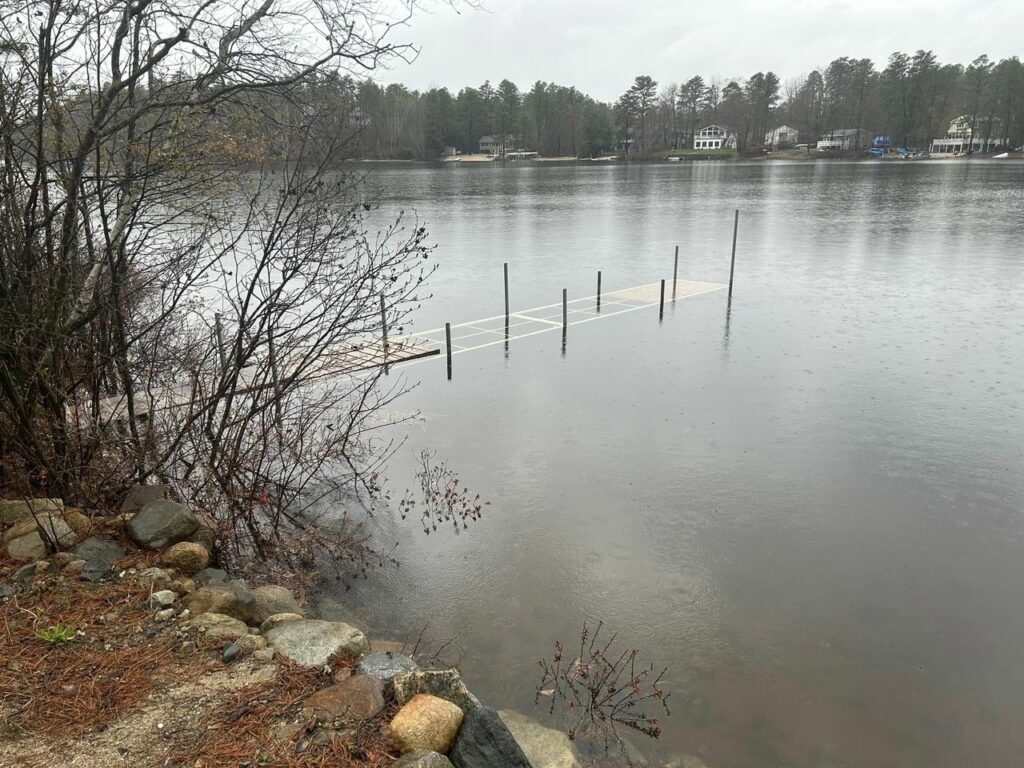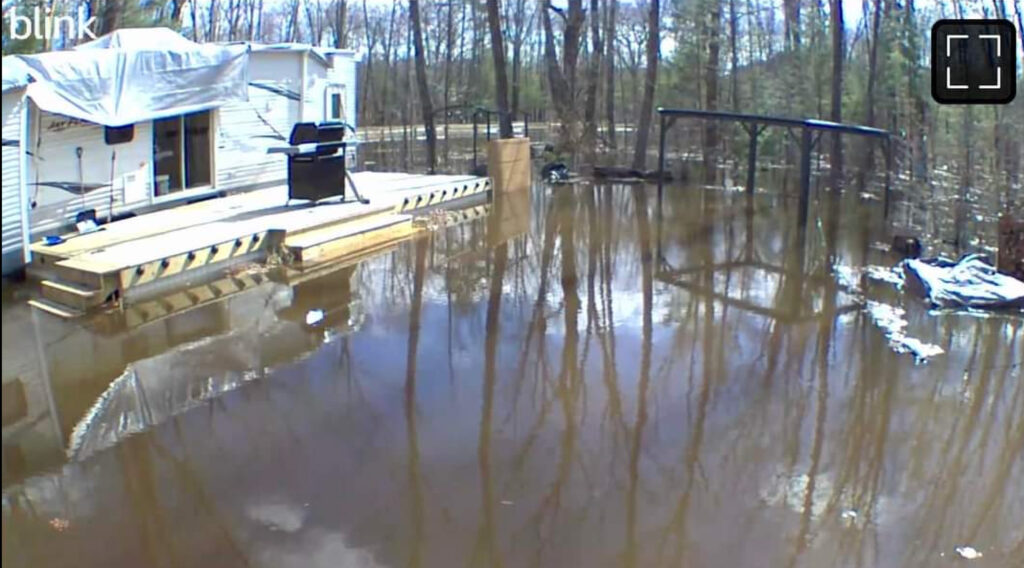Freedom—May 4, 2023—The past week’s major rain event is a reminder that, as “Smart Report” author Bob Smart has often observed, Mother Nature still holds the cards when it comes to Ossipee Lake.
As worries about the rising lake level were posted online and phoned-in to town officials, long-time lake property owners took to social media to offer a perspective for newcomers: high water is a common occurrence from April to early June.
The combination of snowmelt and rain is often the culprit, and in this week’s event approximately five inches of rain fell in a short period of time on already-saturated ground.

This week’s high water washed away panels in this dock. Nuisance flooding of this type remains common on the lake from April to early June, even with the new dam in place.
Water rushed into the lake from the four rivers that feed it, and met the usual resistance at the Broad Bay channel as it flowed toward the Ossipee Dam, the lake’s only outlet. As the rain continued, the volume of water increased and the lake level rose at all points.
Pictures of drifting boats and floating docks with missing panels appeared on social media pages, including Facebook’s “I Boat on Ossipee Lake.”
Long-time Ossipee Lake resident Tim Otterbach was philosophical as he sent friends pictures of the Bearcamp River, which had surrounded his home and inundated his cars.
“When it rains, it floods,” he said.
Responding to the social media posts, Goodhue Marina’s Tim Cupka cautioned that “It’s a little early to be putting docks and boats in.”
That was echoed by Berry Bay Association President Roberta MacCarthy, who said it’s likely that many newcomers don’t fully understand the ups and downs of the lake’s water level cycle.
“It’s tough to watch people putting expensive boats and docks in the water in April without knowing it’s a risk,” she said.
Role of the Ossipee Dam
MacCarthy, who also sits on the Ossipee Dam Authority, said the social media posts show some people also don’t understand the role of the new Ossipee Lake Dam, which was completed in 2021.
She said the dam, which is controlled electronically from Concord, is designed to manipulate the lake level for recreation and public safety, and has an emergency spillway to avert catastrophic flooding of the type that devastated the lake in June, 1998, when the water level hit 413.72’—more than 6 ft. higher than normal.

A Westward Shores camper posted this picture of flooding near his site, saying the campground was delaying the opening of its season because of high water.
MacCarthy called the new dam a “huge improvement” over the dam it replaced, which relied on local workers utilizing “stop logs” to control the lake’s outflow. But some level of occasional high water is inevitable because the lake acts as a kind of ‘bowl’ to the rivers that empty into it.
“Because it is new, we’re still learning about how much flooding can be controlled by the dam,” she said, noting that the high-water mark for this week’s storm appears to have been 410.2′ at the Bearcamp. At the same time, the water level at the dam was 408.5′.
In Concord, meanwhile, the Dam Bureau at DES was monitoring the high water throughout the rain event, according to Operations & Maintenance Engineer Dan Mattaini. He said the agency’s adjustments to the lake’s outflow has to consider the safety of downriver residents as well as those on the lake.
“We have been doing it in stages, ramping up, so as not to release too great an amount of water at one time,” he wrote.
“Unfortunately, heavy intense rain like what was experienced in the area can still bump up the lake for short periods,” he said.

Thanks so much for the clarification. Anyone who has been on the lake for years knows the idiosyncrasies of it, but the logic of the balance provided by the dam is often forgotten until there’s an event like this. Your reminder should be broadcast to those who may not see it here.
Having experienced the variance of the lake from the ‘40s to the ‘90s, there is nothing alarming. It can happen anytime of the year. I am amazed that Spindle Point was allowed to be used as it has been. The has been abused. I was very disappointed with what I saw on my trip last fall.
Considering the drought some states have to cope with, I am thankful for the rain.